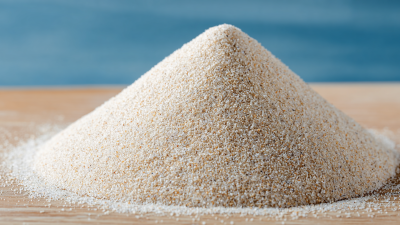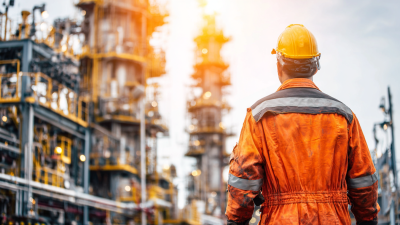

You know, in the oil and gas world, getting that oil-water separation just right is a big deal. That’s where Hydrocyclone Oil Water Separators come into play—they’ve really become a game-changer for tackling this challenge. I came across some recent reports that say these hydrocyclones can remove up to 95% of the oil, which is pretty impressive. Not only does that mean more of those valuable oil resources are saved, but it also helps do right by the environment.

Shanghai Shangjiang Petroleum Engineering Equipment Co., Ltd. has been leading the charge in developing top-notch separation equipment and tech that truly makes a difference. They’re always pushing the envelope to improve their cyclone systems, making sure they keep up with what the industry needs these days.
Whether you’re working offshore or onshore, understanding how to pick the right Hydrocyclone Oil Water Separator for your specific setup is super important if you wanna keep things running smoothly, stay eco-friendly, and stay compliant with regs. It’s all about making smart choices to keep everything efficient and responsible, you know?
Hydrocyclone oil-water separators are pretty much must-haves in many industrial setups, especially when it comes to handling wastewater or recovering oil. If you're trying to pick the right one, it helps to understand how these things actually work. Basically, a hydrocyclone uses centrifugal force—kind of like spinning vigorously—to separate oil from water, thanks to their different densities. So, when the mixture gets into the device, it spins around in a spiral—think of it like a whirlpool—causing the lighter oil to float up to the top while the heavier water sinks down. It’s a pretty efficient system that saves you time and resources when treating oily wastewater.
That said, when you're shopping for a hydrocyclone oil-water separator, it’s important to consider a few things—like how much water you’re processing (flow rate), how much oil’s in there, and what quality of output you need. There are different designs out there, each suited for different volumes and types of oil, so picking the right one really depends on your specific operation. Basically, getting the hang of these basics helps you make smarter choices, ensures the system works well, and keeps you on the right side of environmental regs. It might seem a bit technical at first, but a little knowledge goes a long way!
When you're choosing a hydrocyclone oil-water separator for industrial use, there are a few key things you really wanna keep in mind to get the best performance and efficiency. First off, it’s super important to understand your wastewater’s flow rate and how much oil is in there. That way, you can pick a separator that’s got the right capacity and design to handle what you’re dealing with without any hassle.
**Tip 1:** Take a close look at the size and type of solids in the water. Hydrocyclones work with different particle sizes, so choosing the right one can really make a difference. It’ll give you cleaner separation and help keep your equipment from wearing out too quickly.
Another big factor to think about is whether the separator materials match the chemical makeup of your wastewater. Depending on what's in your water, you’ll wanna go for a hydrocyclone made from materials that won’t easily corrode or wear down. Doing this can seriously extend the life of your equipment and save you some cash on maintenance.
**Tip 2:** Don’t forget to check the pressure drop across the hydrocyclone during operation. A lower pressure drop usually means the separator is working more efficiently. Keeping an eye on this can help you cut energy costs over time, which is always a good thing — especially when you’re running a big operation.

Hydrocyclone oil-water separators are pretty much a staple these days across a bunch of industries because they do a solid job at removing hydrocarbons from water. Take the oil and gas industry, for example — they often use these separators to treat produced water. I mean, according to a report from the International Association of Oil & Gas Producers (IOGP), they’re dealing with about 250 million cubic meters of produced water every single year. That's a staggering amount, right? And with strict regulations in place, these separators need to be really effective — often they can remove over 90% of the oil, which is a big deal for reducing environmental impact and complying with rules.

Then there’s the mining world, where hydrocyclones are also a big help, especially for managing tailings. The World Gold Council points out that gold mining operations churn out around 130 million tons of tailings annually, and those waste heaps can contain leftover oil and even metals. Using hydrocyclones, mines can cut down on oil contamination pretty effectively, helping them stay within environmental regs and show some real commitment to sustainable practices. Oh, and one more thing — since these units have no moving parts and don’t require a lot of upkeep, they’re kind of a no-brainer for these tough, high-demand setups.
Regular maintenance is really key when it comes to keeping your hydrocyclone oil-water separators running smoothly. Honestly, starting with routine checks is the best way to catch any issues early—look out for signs of wear, tear, or clogging that could slow things down. A quick clean every now and then to remove buildup will do wonders for their separation performance, helping you consistently strip oil from water without a hitch.
And don’t forget, it’s super important to keep an eye on the operating conditions, like pressure and flow rates. It’s worth checking these often to make sure everything's within the right range. If you notice anything off, it might mean there’s something under the surface that needs fixing. Keeping good records and analyzing the data can help spot patterns or potential problems before they turn into bigger issues.
Oh, and make sure all the other parts—pumps, piping, valves—are in good shape. Leaks or blockages here can really mess with performance. Spending a little time on proper maintenance and sticking to best practices can seriously boost how long your equipment lasts and how well it works overall. Trust me, a little effort goes a long way!
When you're looking at the cost-effectiveness of hydrocyclone oil-water separators in industry, it’s pretty clear that they’ve got a solid track record for being efficient and versatile. Recent research really emphasizes just how powerful these devices are—being able to separate particles as small as 1 to 10 micrometers with efficiencies anywhere from about 66% all the way up to 99%. That’s especially important in processes where you need to strip out contaminants from oil-based solvents, like the hydrogenated oils used in making petroleum resins. Using hydrocyclone systems can really help cut down on operating costs—since they waste less and boost overall product yield.
On top of that, technology keeps improving. For example, smaller, more advanced hydrocyclones are showing a lot of promise for catching microplastics in water treatment plants, which is a big deal considering how much of a threat they pose to marine life these days. All these innovations not only help companies stay compliant with regulations but also push sustainability forward. That means they’re kind of a win-win—good for the environment and for the long-term health of the business. As industries evolve and face new environmental hurdles, hydrocyclones are becoming a key piece of the puzzle to staying both economically viable and eco-friendly.
When you're picking out a hydrocyclone oil-water separator for your industrial setup, it's really important to avoid some of the common pitfalls if you want everything to run smoothly. One big mistake people often make is overlooking how the unit will impact your operations in the long run. For example, recent research shows that using hydrocyclones can actually change the way activated sludge looks in wastewater treatment plants that have long sludge ages. Getting a good grip on these effects can really help you choose a separator that not only fits your immediate needs but also keeps things running efficiently down the line.
Pro tip: Take some time to check out the latest studies about hydrocyclones in your specific industry. Focus on research that talks about how they perform under different conditions. This way, you’ll better understand how well they can work for your particular setup.
Another mistake folks often make is not paying enough attention to the processing capacity and efficiency. Industry reports stress that choosing a hydrocyclone that’s too small or too big can lead to poor separation and higher operation costs. So, it’s smart to carefully analyze your throughput and treatment goals. That way, you can land on a unit that strikes the right balance between size and performance.
A quick tip: Get in touch with manufacturers to ask for data on how their hydrocyclone models perform under various conditions. This info can give you some solid insights and help you make a smart, informed decision tailored to your specific industrial needs.
: The primary factor is understanding the specific flow rate and oil concentration in your wastewater to select a separator with the appropriate capacity and design.
Assessing the size and type of solids is important because hydrocyclones can handle different particle sizes, and selecting the right unit ensures better separation and reduces wear on the equipment.
It is crucial to choose a hydrocyclone constructed from materials that can withstand corrosion and wear, based on the chemical composition of the wastewater, to prolong equipment lifespan and reduce maintenance costs.
A lower pressure drop during operation can lead to more efficient separation, so evaluating potential pressure drops is important when selecting a hydrocyclone.
Routine inspections to check for wear, clogging, and keeping the hydrocyclone clean are essential maintenance practices to maintain its separation capabilities.
Monitoring pressure and flow rates regularly ensures they remain within optimal ranges, and deviations can indicate underlying issues that need to be addressed.
Implementing a systematic approach to data collection and analysis helps operators identify trends that may indicate potential failures before they occur.
All components, including pumps and piping, should be in good condition, as leaks or blockages can negatively impact the hydrocyclone's performance.
Regular maintenance enhances the longevity and efficiency of hydrocyclone oil water separators, ensuring they operate at optimal performance levels.
Evaluating potential energy costs can save industries money in the long run by improving operational efficiency.
In today’s industrial world, picking the right Hydrocyclone Oil Water Separator isn't just about ticking boxes—it's about making sure your operations run smoothly and stay eco-friendly, too. If you get a good handle on how these separators work—things like flow rates, pressure levels, and particle sizes—you'll have a much easier time choosing the right one. They've got a lot of uses across different industries, really showing just how versatile they are.
Also, don’t forget that regular maintenance is key. Giving your separator some TLC helps it work better and last longer. And yeah, it’s worth thinking about costs too—making sure you get something that fits your budget without sacrificing efficiency. Oh, and a little heads-up: steer clear of common slip-ups like choosing the wrong size or ignoring specific needs for your application—that kind of stuff can really mess with your separation process.
At Shanghai Shangjiang Petroleum Engineering Equipment Co., Ltd., we’re all about pushing forward with cyclonic separation tech. We’re here to be a dependable partner for whatever your industrial needs might be.






